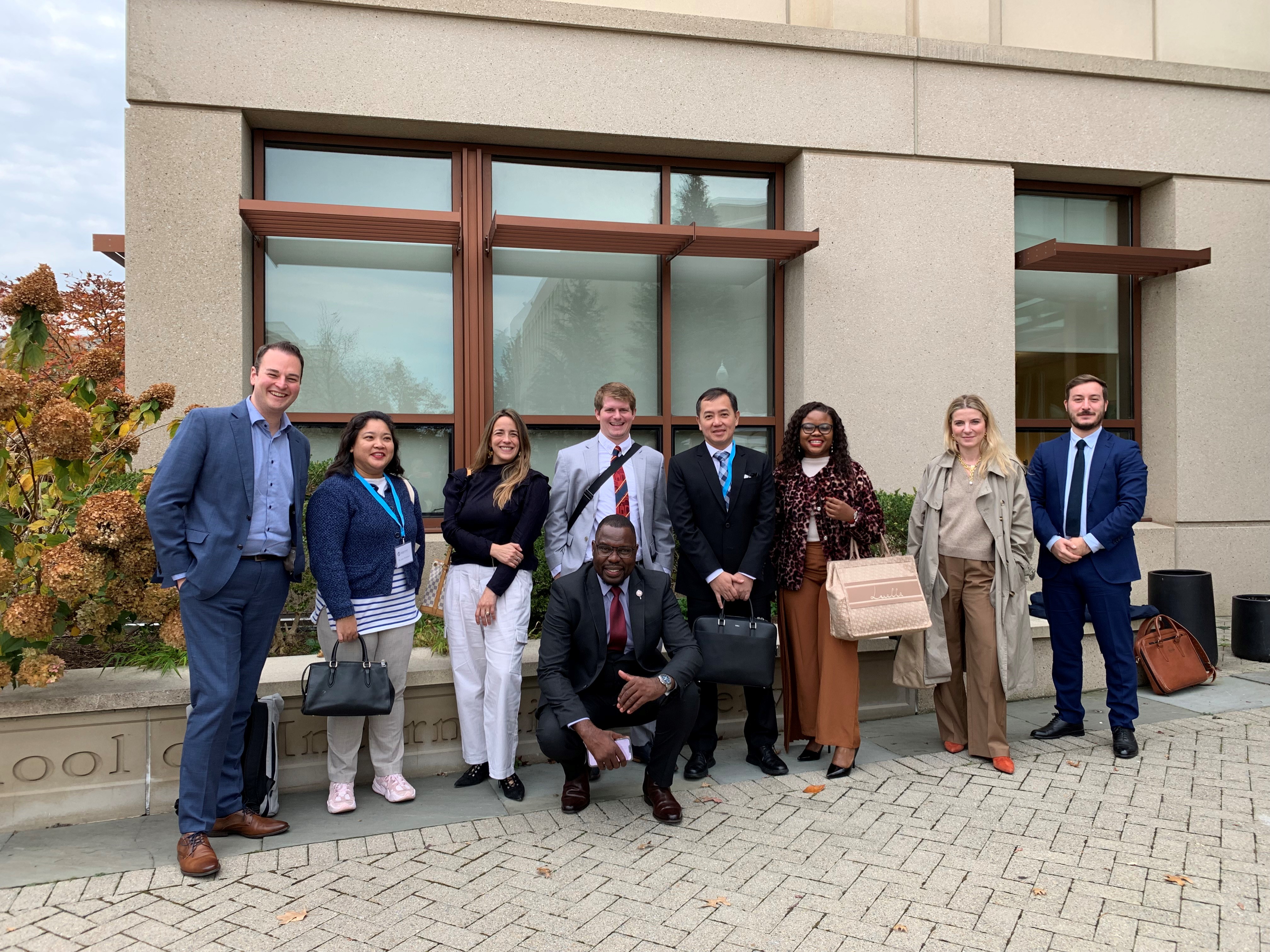Free Trade
Free Trade: How to Win Friends and Build Alliances in the Geoeconomic Age Policy Takeaways

The Friedrich Naumann Foundation’s Washington, DC office hosted a distinguished delegation of eight experts in the area of international trade on a study tour from November 4-11, 2023, in Washington, DC and Houston, Texas. The group was comprised of participants from Chile, South Africa, the Philippines, Malaysia, Turkey, Zimbabwe, Italy, and Germany. The delegation met with experts from various think tanks, universities, the U.S. Congress and local economic organizations, among other constituencies.
Several trends and recurring themes were noted across the meetings. Experts across various institutions touched on legislation passed by Congress during the Biden Administration, and their impacts on U.S. trade policy. Both the White House’s continued stagnant stance on foreign trade policy and the Administration’s rollout of the Inflation Reduction Act were notable topics of discussion. The group also discussed the intersection of climate change and trade, both the present impact and how it will continue to affect trade in the future. A final important theme during the week was the uptick in “friendshoring” and “nearshoring” practices seen across the globe in recent years.
The Biden Administration
Many organizations in both Washington and Houston scrutinized the Biden Administration’s refusal to reverse some of the stricter trade policies introduced under the Trump administration. Some experts remarked that the only notable difference between the two administrations in terms of trade and strategy is the tone in which they approach the table.
A stark example of this tone change followed by inaction can be seen in the Biden administration’s approach to the World Trade Organization (WTO). The position held by the current administration is one that recognizes the importance of the organization and is supportive of its success. However, the White House’s inaction to make the WTO more functional tells a different story. Under the previous administration, former president Trump blocked judge appointments to the organization’s dispute settlement panel. For the last few years, this has left the WTO in a position where they are unable to rule on trade disputes. The Biden administration has not enacted change, which has kept WTO operations more stagnant.
The sentiment, “you can’t build your business plan around who is in the White House”, as is held by some in Houston, reflects the inclination of other regions in the U.S. to engage to the fullest extent in international trade despite various geopolitical tensions.
In addition to the Biden administration, the Inflation Reduction Act (IRA) was a focal point of many conversations.
The Inflation Reduction Act
The impacts already felt by the IRA and outlooks on it moving forward were reiterated by experts across the board. The act, which has only been in motion since August of 2022, has already made a sweeping impact on businesses. While it may be a landmark piece of legislation for the U.S. targeting climate change, the act does not come without criticism.
A common element of the IRA critiqued by several experts was the Electric Vehicle (EV) tax credit. The credit is said to be problematic for various reasons. First and foremost is the cost. The tax credit has no set expiry date, and as a result is going to cost the U.S. government exorbitantly more money than originally expected. The original estimation on cost was around $400 billion USD, but researchers now estimate the spending to be around $1 trillion USD.
Another pinpointed aspect of the act is that it will incentivize foreign production within the United States. The rapid shift of industry coupled with extraordinary tax incentives and credits made available under the IRA is attractive to already established foreign manufacturers.
Energy Infrastructure
A crucial piece of the international trade puzzle is the stability and efficacy of a state’s energy infrastructure.
Energy development is the indispensable base a country needs in order to have other necessary infrastructure. A strong and reliable source of energy is required to support essential services like education, healthcare, and transportation. Furthermore, in order to engage in international trade, access to reliable and sufficient energy sources is inherent.
Texas is a prime case study exemplifying the importance of sufficient and supported energy infrastructure. In the winter of 2021, the extreme cold snap tested and surpassed the ability of Texas’s isolated energy grid. Texas is unique in that it has its own separate grid and supply of energy from the rest of the regions in the United States. An isolated grid is not inherently a recipe for disaster, however without proper fail-safes in place, it can prove to be.
This is what happened when the snow and extreme cold temperatures hit Texas in 2021, causing a higher demand on the grid than what was capable, leaving millions without heat or power. Additionally, methods of protection for parts of the energy infrastructure were elected not to be installed. Notably, wind turbines could have been winterized to withstand the extreme cold temperatures, however companies decided against it, citing cost. The gamble made to not prepare for the extreme cold ended up being much more costly, in more ways than strictly monetary, than the initial cost to winterize.
The resulting disasters from poor planning for an isolated system only further reiterate the need for a secure energy supply and ample back-up energy sources.
Moreover, a steady and reliable energy source serves as a means of autonomy for a state. The greater a state’s reliance on energy from other nations or regions is, the less autonomy a state actually retains. This also demonstrates that energy is a means of security. When a country is less dependent on others for their energy, it strengthens their ability to operate unhindered in the geopolitical sphere. In this sense, autonomy is security. In regards to trade, when a state has a greater degree of autonomy, they also have greater leverage navigating trade deals.
Climate Change and Trade
Another facet of international trade the group discussed was both the present impact of climate change and its predicted impact over the next several decades. Already, farmers are feeling the effects of climate change with shorter growing seasons, more extreme temperatures and an uptick of catastrophic weather events.
In the U.S. alone, every single crop utilized in the supply chain is experiencing a greater degree of climate burden than is outweighed by climate boosts. Over the next few decades the world will experience a significant loss of usable land and overall yield of crops. The continued dwindling domestic supply will only further alter the composition of U.S. imports and exports. The United States is already slipping into a pattern of deficit over the last few years, where normally it maintains an agricultural trade surplus.
In addition to crop migration due to climate change, there will also be a significant movement of people. As catastrophic events continue to occur, populations will shift to more suitable and habitable lands, only further altering the international trade landscape.
Friendshoring and Nearshoring Tendencies
One of the most discussed trends throughout the entire tour was the recent trend of increased friendshoring and nearshoring policies globally.
Discussions centered on the pitfalls in the supply chain elucidated by the pandemic. Many countries’ reaction to this shock was to implement measures that would reinforce and stabilize their own supply chain. One way to accomplish this is to bring outsourced goods and services closer to home. With the goods and services being sourced and or produced more locally or regionally, the shortcomings onset by a supply chain disruption are mitigated significantly.
This shift in trading partners can be exemplified by the recent modification to major trade partners by the U.S., as China has previously dominated as the top trading partner for and with the United States. Presently, Canada and Mexico now reign as the largest trading partners with the U.S., sliding China into third place. Major reshuffling of lead trading partners is not uniquely a North American trend. Every corner of the world, to some degree, is experiencing a restructure. This sentiment of reorganization is bipartisan in nature, solidifying it as a new policy direction that will not be easily altered.
Conclusion
The current state of the international trade landscape is one undergoing various shifts. A major stagnant piece from the American side of trade is the Biden administration’s apparent lack of action to update policy. However, the sweeping IRA legislation has significantly altered major industries. Furthermore, stable energy flow continues to be a vital component to maintaining global trade. Another element of the discussion whose impact cannot be overlooked is climate change. Its affects cannot go unaccounted for. Some present trends, like friendshoring and nearshoring, are expected to be a more permanent fixture over the coming years. All in all, the international trade landscape is still finding its footing in the post-pandemic era amidst a world rife with geopolitical tensions.
